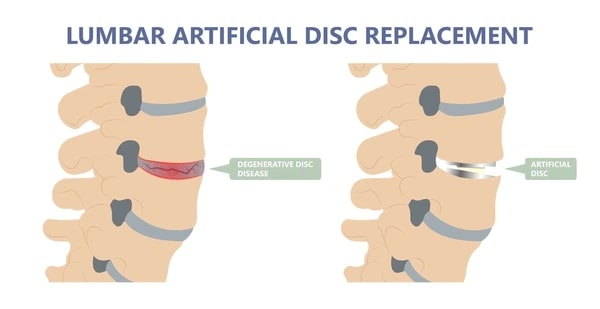Introduction
The lumbar spine, located in the lower back, is crucial for movement and support. However, issues like degenerative disc disease can cause significant pain and mobility problems. One innovative solution is lumbar artificial disc replacement, a procedure designed to relieve pain and restore function.
This blog explores what lumbar artificial disc replacement involves, its benefits, and why Pinnacle Orthocentre Hospital offers the best care for this procedure.
Understanding Lumbar Artificial Disc Replacement
Definition and Purpose
Lumbar artificial disc replacement is a surgical procedure aimed at replacing a damaged or degenerated disc in the lower spine with an artificial disc. Unlike traditional fusion surgery, which limits movement by fusing two vertebrae, artificial disc replacement maintains the spine’s natural motion.

The Procedure of Lumbar Artificial Disc Replacement
Preoperative Preparation
Before undergoing artificial lumbar disc surgery, patients undergo thorough consultations and diagnostic tests to ensure they are suitable candidates. This includes imaging studies like X-rays or MRIs and physical assessments.
Surgical Process
- Anesthesia and Positioning: Patients receive general anesthesia and are positioned to allow optimal access to the spine.
- Incision and Access: Surgeons make an incision to access the damaged disc.
- Disc Removal and Replacement: The damaged disc is carefully removed, and the artificial disc is implanted in its place.
Postoperative Care
Post-surgery, patients are monitored in the hospital, with pain management and physical therapy starting soon after. Long-term follow-up appointments are crucial to ensure proper recovery and monitor the artificial disc.
Benefits of Lumbar Artificial Disc Replacement
Advantages Over Traditional Fusion Surgery
- Improved Mobility: Unlike fusion surgery, which restricts movement, artificial disc replacement preserves the spine’s natural motion.
- Reduced Pain: Many patients experience significant pain relief after the procedure.
- Faster Recovery: The recovery period is often shorter compared to traditional fusion surgery.
Success Rates and Clinical Outcomes
Numerous studies have shown high success rates for artificial disc replacement in spine surgery. Patients often report improved quality of life and reduced pain. At Pinnacle Orthocentre Hospital, patient testimonials highlight successful outcomes and satisfied patients.
Risks and Complications
Potential Risks
While generally safe, lumbar disk replacement surgery carries some risks, including infection, device failure, and nerve damage. However, these complications are rare and manageable with proper care.
Long-term Considerations
Artificial discs are designed to be durable, but like any medical device, they may eventually need replacement. Regular follow-ups with your surgeon ensure any potential issues are detected early.
Who is a Candidate for Lumbar Artificial Disc Replacement?
Ideal Candidates
Ideal candidates for lumbar artificial disc replacement are typically younger, active individuals with specific lumbar spine conditions that have not responded to conservative treatments.
Conditions Not Suitable for Surgery
Certain conditions, such as severe osteoporosis or spinal infections, may preclude patients from undergoing artificial disc replacement. It’s essential to consult with a specialist to determine the best treatment plan.
Choosing the Right Surgeon and Facility
Expertise at Pinnacle Orthocentre Hospital
Selecting an experienced surgeon and a reputable facility is critical for a successful outcome. Pinnacle Orthocentre Hospital in Thane boasts top surgeons with extensive experience in artificial disc replacement in spine surgery.
Frequently Asked Questions (FAQs)
Q. How long is the recovery period?
A. The recovery period varies but typically ranges from a few weeks to a few months, depending on individual factors.
Q. What activities can I resume after surgery?
A. Most patients can return to normal activities gradually, with specific guidelines provided by their surgeon.
Specific Concerns
Q. How to manage pain post-surgery?
A. Pain management strategies include medication, physical therapy, and follow-up care.
Q. What is the lifespan of an artificial disc?
A. Artificial discs are designed to last many years, with regular monitoring to ensure longevity.
Conclusion
Lumbar artificial disc replacement offers a promising solution for those suffering from chronic back pain and limited mobility due to degenerative disc disease.
Pinnacle Orthocentre Hospital provides the best care, utilizing advanced technology and experienced surgeons to ensure successful outcomes.
For the best lumbar artificial disc replacement in Thane, contact Pinnacle Orthocentre Hospital today. Schedule a consultation to discuss your condition and explore treatment options.
Read patient reviews and success stories to understand why Pinnacle Orthocentre Hospital is the top choice for spine surgery.






0 Comments